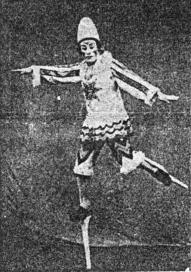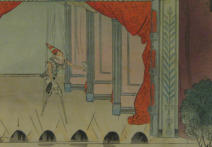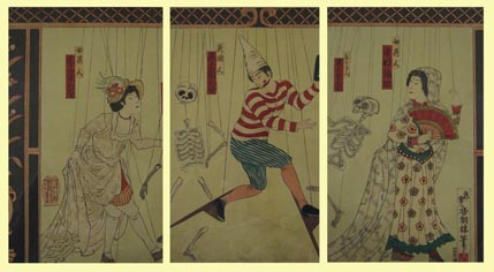NAVIGATION
SOCIAL
CONTACT
e-mail: info@theworldthroughwoodeneyes.co.uk

Onoe
Kikugoro
V
(1844-1903)
was
described
as
an
all-round
actor
–
‘Man
of
a
Thousand
Faces’
–
an
actor
who
can
play
any
role.
Born
in
Asakusa,
grandson
of
Kikugoro
III.
Despite
his
work in traditional Kabuki plays, he worked to adapt old styles to new tastes.
There
is
little
doubt
that
Kikugoro
V
was
a
very
popular
actor
celebrated
in
vast
numbers
of
woodblock
prints,
primarily
by
Toyohara
Kunichika.
One
series
of
prints
had
the
title
Baiko
Hyaku-shu No Uchi’, - ‘One Hundred Roles of Onoe Baiko’. He was also featured on Japanese postage stamps.
In
1897
a
film
with
the
title
‘Momijigari’
–
‘Maple
Viewing’
was
made,
with
Onoe
Kikugoro
and
Ichikawa
Danjuro
in
the
leading
roles.
He
played
male
roles
as
well
a
number
of
onagata
(female roles). One role he performed in a film, was the character Princess Sarashina disguised as an ogress.
One
of
his
innovations
was
to
perform
characters
based
on
the
marionettes
of
the
D’Arc
Troupe
who
visited
Japan.
A
dance
play
‘Marionettes
Imitating
the
Sound
of
a
Bell’,
was
given
in
the
Ichimura
Za
in
July
1894
in
which
Onoe
Kikugoro
V
imitates
marionettes,
for
example
a
marionette
on
stilts.
Photographs
in
a
Japanese
journal
show
Kikugoro
in
this
role,
also
a
poster
showing a montage of traditional marionette theatre turns.
The
performances
at
the
Ichimura
Za
were
packed
out,
despite
the
intense
heat
of
a
very
hot
summer.
The
D’Arc
Troupe
were
to
return
to
the
UK
in
summer
1894,
but
the
success
of
performances
ensured
that
it
stayed
much
longer.
His
enthusiasm
for
the
marionette
performances
led
Kikugoro
to
a
friendship
with
the
company
and
D’Arc,
often
watching
the
marionette
performances
and
engaging
in
dialogues
with
principle members of the troupe during the intervals in the performances.
The
D’Arc
Troupe
had
a
Japanese
manager
–
Matsune
Suekichi,
he
died
in
1913
at
the
age
of
63.
When
D’Arc
returned
to
the
UK
Matsune
took
over
the
puppets
and
stage
properties
and
continued
to
give
performances.
After
the
death
of
Matsune
Suekichi,
a
certain
Mr
Matsushima
and
his
two
sons
continued
to
perform
with
the
marionettes
until
the
end
of
the
1920s
in
the
Hanayashiki
(Flower
Residence),
an
amusement
park
that
still
exists.
The
store
at
the
Hanayashiki
was
said
to
have
contained
all
kinds
of
puppets,
including
dissecting
skeletons
and
all
kinds
of
insects, apparently made by D’Arc.
A
Triptych
by
Oji
Kochoro
–
Kunisada
III,
shows
five
characters
including
Onoe
Eisaburo
as
a
foreign
woman.
Onoe
Kikugoro
V
as
an
Englishman
(Drunken
stilt
walking
clown),
Onoe
Ushinosuke
(infant
child’s
stage
name
of
Kikugoro
VI),
as
skeleton and Nakamura Fukusuke as a foreign woman.
A
Single
woodblock
print
by
Tsukioka
Kogyo
(1869-1927)
who
made
a
specialism
of
Noh
theatre
prints,
showing
the
proscenium
and
stage
of
the
D’Arc
marionette
theatre
on
which
a
drunken
stilt-walking
clown
is
seen
in
performance.
There
is
a
small panel on the top-right of the print showing dissecting skeleton.
Kogyo
was
the
son
of
an
innkeeper
in
Nihonbashi,
Tokyo.
His
mother
married
the
ukiyo-e
master
Tsukioka
Yoshitoshi
in
1884
and
the
young
Kogyo
took
lessons
and
a
new
surname
from
his
stepfather.
He
also
studied
with
the
painter
and
ukiyo-e
printmaker
Ogata
Gekko
(1859-1920)
who
gave
him
the
name
Kogyo.
Kogyo
was
a
craftsman
and
print
designer,
worthy
enough
to
inherit Yoshitoshi’s artists seals in October 1910 and carry on the practise of traditional ukiyo-e printmaking.
Kikugoro
V
with
Danjuro
IX
were
considered
to
be
two
of
the
greatest
actors
that
Japan
has
ever
produced.
Although
they
both
continued
the
legacy
left
to
them
by
a
long
line
of
their
actor
ancestors,
the
decline
in
critical
audiences
for
Kabuki
and
traditional
forms
let
them
seek
greater
satisfaction
in
their
own
work.
Aware
of
influences
from
other
countries
they
preserved
traditional forms and styles and also created new forms. They developed less gaudy costumes and grotesque make-up to relate to their more human styles of acting.
In
Kabuki
forms,
to
Kikugoro
V
historical
plays
were
less
interesting
to
him
and
he
tended
to
excel
in
domestic
plays,
plays
of
ordinary
people
of
the
era
acted
in
traditional
classical
style.
Previous
to
the
Meiji
Era
the
male
status
was
indicated
by
his
hair
style.
In
the
Meiji
Era
it
became
the
fashion
for
all
classes
to
wear
close-cropped
hair.
This
led
to
the
development
of
what
were
known
as
‘Cropped
Hair
Plays’.
The
appearance
of
characters
wearing
costume
and
hair-styles
of
the
Meiji
Era
became
an
new
move
towards
the
development
of
modern
or
contemporary theatre in Japan.
The
new
experiments
were
not
without
problems
but,
in
general
terms
they
had
a
positive
effect
on
the
Kabuki
theatre.
One
factor
was,
that
after
the
presentation
of
a
command
performance for the Meiji Emperor (1887) the status of the actor in Japan was assured.
The
history
of
Bunraku
and
Kabuki
are
inextricably
linked
and
share
the
same
repertoire.
Each
year,
it
is
the
practice
for
three
kabuki
actors
performing
the
role
of
puppeteers
to
manipulate
a
fourth
actor
in
the
style
of
the
Bunraku
figure,
this
in
recognition
of
the
Kabuki
origins.
It
is
interesting
that
Kikugoro
must
have
been
fully
aware
of
the
Bunraku,
and
presumably
other
types
of
Japanese
puppet,
but
it
was
the
marionettes
from
the
UK
that
had
a
major
impact
on
his
work.
Kikugoro
was
also
familiar
with
British
plays,
and
it
seems
that
he
adapted
them
for
a Japanese audience.
In
the
middle
of
the
18th
century
puppet
theatres
in
Japan
overshadowed
the
Kabuki.
As
a
result
of
government
restrictions
on
live
actors
Kabuki
lost
its
leading
practitioners.
The
work
of
the greatest writers became focused on the puppet theatres. Later, Kabuki actors took the plots, imitated the movements of the puppets and adapted declamation styles.
The
Bunraku
remained
popular
with
audiences,
but
it
was
said
that
they
were
more
impressed
by
watching
the
live
Kabuki
actors
performing
as
puppets.
Late
in
the
18th
century
Kabuki
re-
established its dominance over the Bunraku, and remains the most popular form of classical theatre in Japan.
ONOE KIKUGORO V
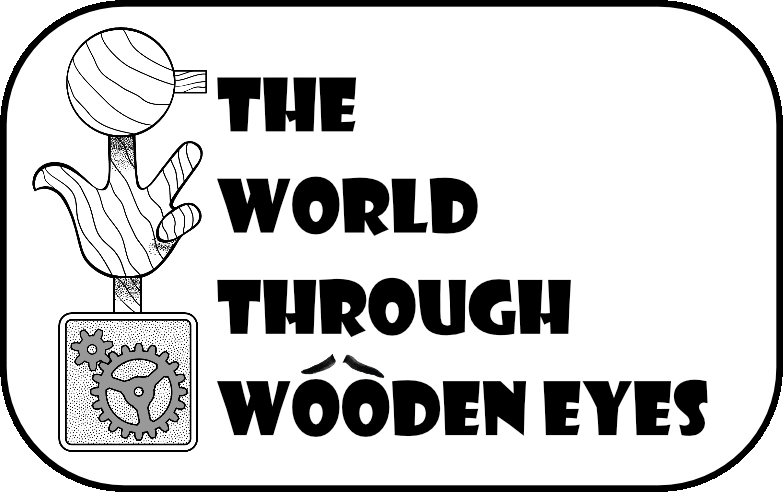
CONTACT
e-mail: info@theworldthroughwoodeneyes.co.uk
SOCIAL
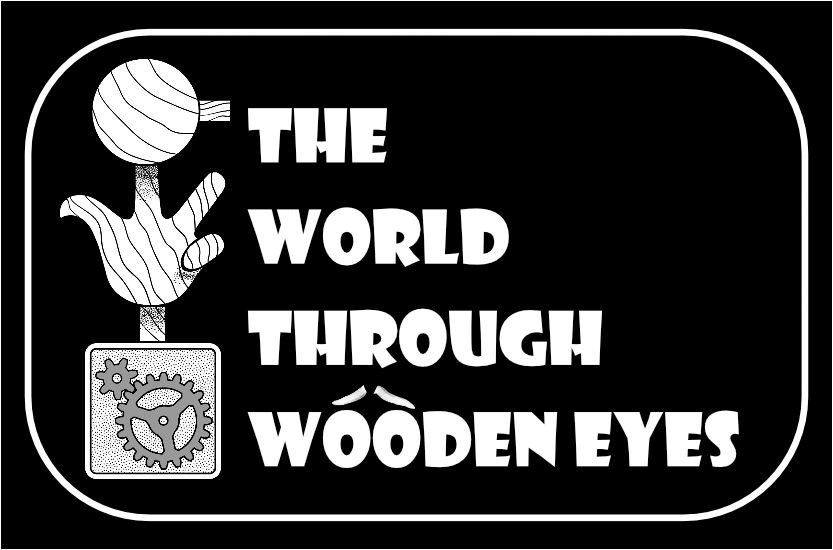

Onoe
Kikugoro
V
(1844-1903)
was
described
as
an
all-round
actor
–
‘Man
of
a
Thousand
Faces’
–
an
actor
who
can
play
any
role.
Born
in
Asakusa,
grandson
of
Kikugoro
III.
Despite
his
work
in
traditional
Kabuki
plays,
he
worked
to
adapt
old
styles
to
new
tastes.
There
is
little
doubt
that
Kikugoro
V
was
a
very
popular
actor
celebrated
in
vast
numbers
of
woodblock
prints,
primarily
by
Toyohara
Kunichika.
One
series
of
prints
had
the
title
Baiko
Hyaku-
shu
No
Uchi’,
-
‘One
Hundred
Roles
of
Onoe
Baiko’.
He
was
also
featured on Japanese postage stamps.
In
1897
a
film
with
the
title
‘Momijigari’
–
‘Maple
Viewing’
was
made,
with
Onoe
Kikugoro
and
Ichikawa
Danjuro
in
the
leading
roles.
He
played
male
roles
as
well
a
number
of
onagata
(female
roles).
One
role
he
performed
in
a
film,
was
the
character
Princess
Sarashina disguised as an ogress.
One
of
his
innovations
was
to
perform
characters
based
on
the
marionettes
of
the
D’Arc
Troupe
who
visited
Japan.
A
dance
play
‘Marionettes
Imitating
the
Sound
of
a
Bell’,
was
given
in
the
Ichimura
Za
in
July
1894
in
which
Onoe
Kikugoro
V
imitates
marionettes,
for
example
a
marionette
on
stilts.
Photographs
in
a
Japanese
journal
show
Kikugoro
in
this
role,
also
a
poster
showing
a montage of traditional marionette theatre turns.
The
performances
at
the
Ichimura
Za
were
packed
out,
despite
the
intense
heat
of
a
very
hot
summer.
The
D’Arc
Troupe
were
to
return
to
the
UK
in
summer
1894,
but
the
success
of
performances
ensured
that
it
stayed
much
longer.
His
enthusiasm
for
the
marionette
performances
led
Kikugoro
to
a
friendship
with
the
company
and
D’Arc,
often
watching
the
marionette
performances
and
engaging
in
dialogues
with
principle
members
of
the
troupe
during the intervals in the performances.
The
D’Arc
Troupe
had
a
Japanese
manager
–
Matsune
Suekichi,
he
died
in
1913
at
the
age
of
63.
When
D’Arc
returned
to
the
UK
Matsune
took
over
the
puppets
and
stage
properties
and
continued
to
give
performances.
After
the
death
of
Matsune
Suekichi,
a
certain
Mr
Matsushima
and
his
two
sons
continued
to
perform
with
the
marionettes
until
the
end
of
the
1920s
in
the
Hanayashiki
(Flower
Residence),
an
amusement
park
that
still
exists.
The
store
at
the
Hanayashiki
was
said
to
have
contained
all
kinds
of
puppets,
including
dissecting
skeletons
and
all
kinds
of
insects,
apparently
made by D’Arc.
A
Triptych
by
Oji
Kochoro
–
Kunisada
III,
shows
five
characters
including
Onoe
Eisaburo
as
a
foreign
woman.
Onoe
Kikugoro
V
as
an
Englishman
(Drunken
stilt
walking
clown),
Onoe
Ushinosuke
(infant
child’s
stage
name
of
Kikugoro
VI),
as
skeleton
and
Nakamura Fukusuke as a foreign woman.
A
Single
woodblock
print
by
Tsukioka
Kogyo
(1869-1927)
who
made
a
specialism
of
Noh
theatre
prints,
showing
the
proscenium
and
stage
of
the
D’Arc
marionette
theatre
on
which
a
drunken
stilt-
walking
clown
is
seen
in
performance.
There
is
a
small
panel
on
the top-right of the print showing dissecting skeleton.
Kogyo
was
the
son
of
an
innkeeper
in
Nihonbashi,
Tokyo.
His
mother
married
the
ukiyo-e
master
Tsukioka
Yoshitoshi
in
1884
and
the
young
Kogyo
took
lessons
and
a
new
surname
from
his
stepfather.
He
also
studied
with
the
painter
and
ukiyo-e
printmaker
Ogata
Gekko
(1859-1920)
who
gave
him
the
name
Kogyo.
Kogyo
was
a
craftsman
and
print
designer,
worthy
enough
to
inherit
Yoshitoshi’s
artists
seals
in
October
1910
and
carry
on
the
practise
of traditional ukiyo-e printmaking.
Kikugoro
V
with
Danjuro
IX
were
considered
to
be
two
of
the
greatest
actors
that
Japan
has
ever
produced.
Although
they
both
continued
the
legacy
left
to
them
by
a
long
line
of
their
actor
ancestors,
the
decline
in
critical
audiences
for
Kabuki
and
traditional
forms
let
them
seek
greater
satisfaction
in
their
own
work.
Aware
of
influences
from
other
countries
they
preserved
traditional
forms
and
styles
and
also
created
new
forms.
They
developed
less
gaudy
costumes
and
grotesque
make-up
to
relate
to their more human styles of acting.
In
Kabuki
forms,
to
Kikugoro
V
historical
plays
were
less
interesting
to
him
and
he
tended
to
excel
in
domestic
plays,
plays
of
ordinary
people
of
the
era
acted
in
traditional
classical
style.
Previous
to
the
Meiji
Era
the
male
status
was
indicated
by
his
hair
style.
In
the
Meiji
Era
it
became
the
fashion
for
all
classes
to
wear
close-cropped
hair.
This
led
to
the
development
of
what
were
known
as
‘Cropped
Hair
Plays’.
The
appearance
of
characters
wearing
costume
and
hair-styles
of
the
Meiji
Era
became
an
new
move
towards
the
development
of
modern
or
contemporary
theatre in Japan.
The
new
experiments
were
not
without
problems
but,
in
general
terms
they
had
a
positive
effect
on
the
Kabuki
theatre.
One
factor
was,
that
after
the
presentation
of
a
command
performance
for
the
Meiji Emperor (1887) the status of the actor in Japan was assured.
The
history
of
Bunraku
and
Kabuki
are
inextricably
linked
and
share
the
same
repertoire.
Each
year,
it
is
the
practice
for
three
kabuki
actors
performing
the
role
of
puppeteers
to
manipulate
a
fourth
actor
in
the
style
of
the
Bunraku
figure,
this
in
recognition
of
the
Kabuki
origins.
It
is
interesting
that
Kikugoro
must
have
been
fully
aware
of
the
Bunraku,
and
presumably
other
types
of
Japanese
puppet,
but
it
was
the
marionettes
from
the
UK
that
had
a
major
impact
on
his
work.
Kikugoro
was
also
familiar
with
British
plays, and it seems that he adapted them for a Japanese audience.
In
the
middle
of
the
18th
century
puppet
theatres
in
Japan
overshadowed
the
Kabuki.
As
a
result
of
government
restrictions
on
live
actors
Kabuki
lost
its
leading
practitioners.
The
work
of
the
greatest
writers
became
focused
on
the
puppet
theatres.
Later,
Kabuki
actors
took
the
plots,
imitated
the
movements
of
the
puppets and adapted declamation styles.
The
Bunraku
remained
popular
with
audiences,
but
it
was
said
that
they
were
more
impressed
by
watching
the
live
Kabuki
actors
performing
as
puppets.
Late
in
the
18th
century
Kabuki
re-
established
its
dominance
over
the
Bunraku,
and
remains
the
most
popular form of classical theatre in Japan.
ONOE KIKUGORO V












